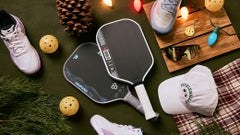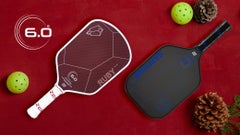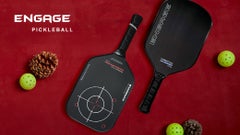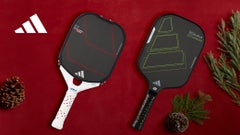How to Customize Your Pickleball Paddle
We explain why you might consider customizing your paddle and how to add weight to improve comfort, power, stability, and even maneuverability.
Why You Might Consider Customization?
Maybe you’ve heard players talking about customizing their pickleball paddles, or perhaps you’ve already done a bit of research on the topic. You also might be wondering what the benefits are in terms of what can be achieve through paddle customization. In short, depending where you add weight and how much, you can either increase paddle power and stability or enhance paddle maneuverability.
Getting Started: Customization Materials
Tungsten Tape: Tungsten is denser compared to lead on the periodic chart of elements so your paddle will not require as much material to achieve the desired performance. And because tungsten is considered non-toxic (safe to handle), we prefer to use it in lieu of lead when customizing paddles. Most often, tungsten tape is sold in pre-cut strips that are a quarter-inch wide. You can then trim the tungsten tape to the desired weight. Another favorable aspect of using tungsten is that you can remove and reapply the same strip to another spot on your paddle.
Lead Tape: Lead, like tungsten, is a dense material that can be used in paddle customization, with the caveat being that it is considered a potentially harmful material and in California carries the Proposition 65 warning. Typically, lead tape is dispensed in quarter- or half-inch widths and features an adhesive on one side to secure it to the spot where it is placed. Listed on the packaging is an indication (in grams) of how much weight is added per inch of tape length.
Overgrips: An overgrip will increase the comfort level, grip diameter and paddle weight. A typical overgrip (depending on how much is trimmed) weighs around 8.5 grams. Applying an overgrip tail weights a paddle, and without countering that with more weight in the face area helps make a paddle feel a little speedier on the swing.
Protective Paddle Tape: Protective head tape not only protects your edge guard, but it also adds weight. Protective tape is applied around the edge end of the paddle and will increase power due to the extra weight. Many players also apply tungsten or lead, then cover it with protective tape.
How Much Weight Should You Add?
An ideal paddle weight is dependent on the player, but you’ll want it to be substantial enough to be stable at ball contact but not so heavy that you cannot swing it effectively. The best weight is the one that strikes a balance between paddle power/stability and maneuverability. That said, think in terms of grams and not ounces.
Comparing the variety of weights there are for bowling balls to pickleball paddles is good way to explain what kind of performance you get from using either more mass or velocity. A lighter ball is easier to hurl down the lane, but due to the lack of mass, requires more ball velocity (effort from the player) to effectively split the pins. A heavier bowling ball has more pin-splitting potential and does not require as much ball speed to get the job done. However, this only works if the person in question can effectively wield it.
A heavier paddle plows through ball contact like the heavier bowling ball does through the pins. Generally speaking, a paddle weight in the high 7-ounce range or more will offer better plow through and be less prone to shake or twist in your hand, especially if ball contact is off center or if the conditions are windy.
Even a small amount of weight applied to your paddle will have a noticeable effect on its feel and performance. As a result we suggest adding small increments of weight and then test how it affects your game. Suffice it to say an increase of just 9 grams will be noticeable no matter how the weight is distributed.
How to Improve Comfort
To a degree, more paddle material (weight) equals better vibration control and thus comfort. In a general sense, the heavier your paddle is the better it will be in terms of its ability to diminish vibration created at impact of ball. You just don't want to add so much weight that you feel like you entirely exchanged paddle agility for comfort.
How to Improve Stability and Power
Manufacturers often use varying densities of foam around the perimeter of their paddles, which expands the size of the sweetspot (more power) and also helps with paddle stability and comfort. Applying aftermarket weight along the perimeter of a paddle has that same effect.
The general rule of thumb is the farther away from the handle you add weight, the easier it is to notice while playing.


Additional weight added to either side of the paddle face, down near the neck, will increase power and stability with a minimal sacrifice to maneuverability. The same amount of weight applied farther up the paddle face, say at the 3 and 9 spots, will increase both power and stability even more, but depending on how much extra weight is added might come at the expense of maneuverability.
Placing weight at the very tip or 12 o'clock spot of the paddle face is where a player would notice the extra weight the most and would definitely add power but not stability. Or in other words, adding weight just to that spot alone will not help prevent the paddle from wobbling or twisting side-to-side on off-center ball contact.
How to Make a Paddle Feel More Maneuverable
If your paddle feels a little cumbersome or slow while swinging it, you can add weight on the handle end of the paddle. The closer to end of the handle you add weight, the less you will notice the increase in weight. Applying the weight below the paddle’s balance point will make the paddle feel more agile even though the overall static weight increases. The balance point relates to where the majority of the paddle’s weight is situated, whether it’s toward the tip or toward the handle. Paddles with more weight toward the tip will feel heavier, whereas if more weight is on the handle end, the paddle will likely feel easier to swing.)
Paddle Customization Tips
- Adding weight to the tip of the paddle will build power and increase stability on the swing but will not help prevent the paddle from twisting.
- Weight added to the handle end, up to a point, will improve paddle maneuverability, but similar to adding weight at the tip, it will not really prevent the paddle from twisting laterally during off-center ball contact.
- Applying weight on both the sides of the paddle face (3 and 9 o'clock) delivers a “best of both worlds” effect on performance, improving stability on the swing and helping to prevent a paddle from feeling unstable or twisting in your hand.
- Because most paddles feature a slight tip light balance in stock form, one of the more common/popular ways to modify a paddle is to apply an overgrip and then add equal amounts of tungsten or lead tape on both edge-sides of the lower portion of the paddle face. The overgrip improves comfort, and combined with the tape, affords better stability and power without having to sacrifice much in the way of maneuverability.
In Conclusion
Although we can predict the effect of adding weight to a specific spot of the paddle, it is ultimately up to you to decide what feels best while you’re playing. In many instances adding a little bit of weight is perfect for limiting how much a paddle wobbles but too much can inhibit maneuverability. Because even small changes often produce a huge difference in performance, there may be some trial and error involved while you fine-tune your paddle through customization.







